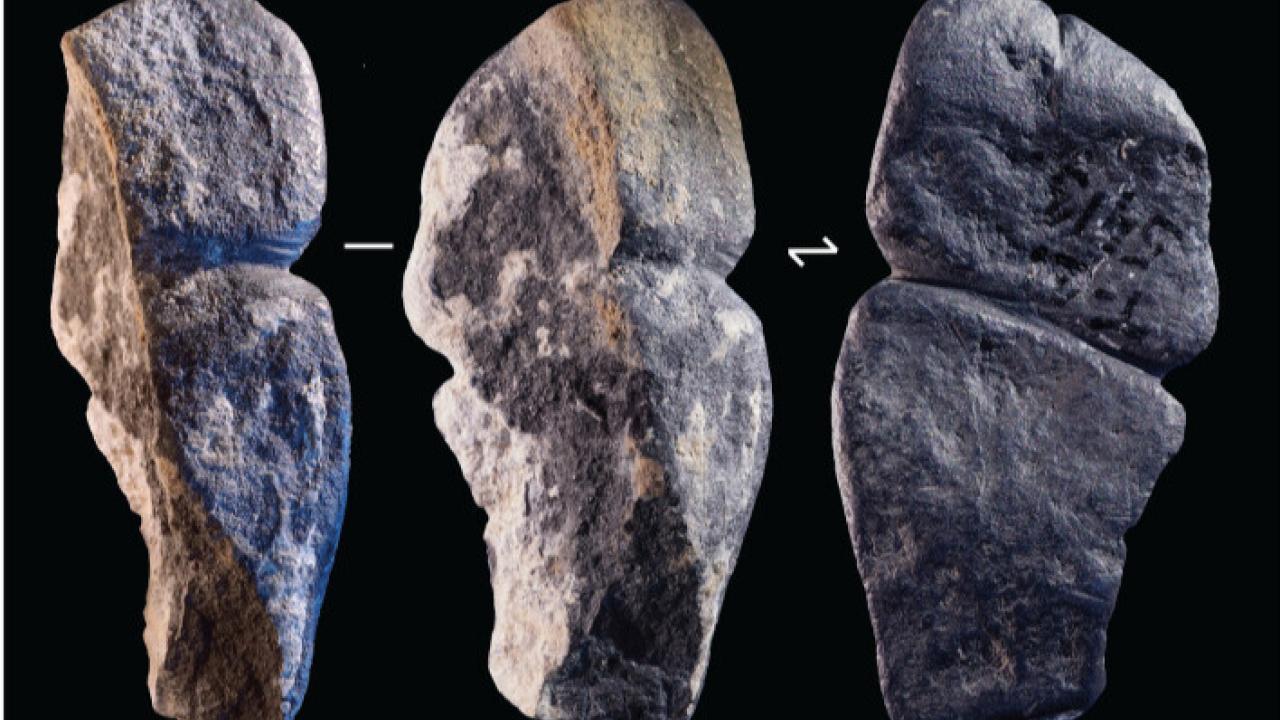Quick Summary
- A study published in Scientific Reports describes and analyzes a phallus-shaped black pendant discovered in northern Mongolia and dating back to 42,000 years ago.
- In addition to pushing back the timeline for sexed symbolic representation in the archaeological record, the pendant was discovered in a location where Homo sapiens mingled with other ancient human species, including the extinct Denisovans.
- The research adds more fuel to the debate about whether figurative depictions in art was a trait exclusive to Homo sapiens in ancient human history.
“The earliest known evidence of personal ornaments dates back to approximately 140,000 years ago,” said lead author Solange Rigaud, of the University of Bordeaux and the French National Centre for Scientific Research. “However, it wasn’t until 42,000 years ago that sexed attributes began to be represented in personal ornamentation.”
In addition to pushing back the timeline for sexed symbolic representation in the archaeological record, the pendant was discovered in a location where Homo sapiens mingled with other ancient human species, including the extinct Denisovans.
“The potential cultural implications of the encounters between different hominin groups in Central Asia are fascinating and can provide valuable insights into the development of human cultures,” Rigaud said of the study’s impact. “We believe that during this particular period, encounters between different hominins likely altered the way they perceived themselves and, at least in the case of Homo sapiens, resulted in new ways of adorning the body.”
The research adds more fuel to the debate about whether figurative depictions in art was a trait exclusive to Homo sapiens in ancient human history.
"Although figurative art seems to emerge independently in Europe and Southeast Asia, it does so during a pivotal period prior to the definite establishment of our species, when encounters with other humans are documented in the genetic record," said UC Davis Associate Professor of Anthropology Nicolas Zwyns, who coordinated the study with Rigaud. "The pendant is an additional piece of that jigsaw puzzle, in a region where suspended sexual representations of that age were unknown."
Foraging for materials
Measuring roughly 43.4 mm long, 21.4 mm wide and 13.9 mm thick, the black pendant was a unique find for the team due to its material. Fashioned from graphite, it was uncovered in the western flank of the Tolbor River Valley in the Northern Khangia Mountains. But graphite isn’t local to the region. The closest source is roughly 150 miles away, far exceeding the expected daily foraging range for hunter-gatherers of the time.
What does the research mean?
The research adds more fuel to the debate about whether figurative depictions in art was a trait exclusive to Homo sapiens in ancient human history.
“The foragers from Tolbor may have acquired the graphite (or the pendant itself) during their nomadic displacement, which likely spanned over a large territory,” Rigaud said. “While they themselves might not have been near the graphite source, they probably encountered other groups with whom they could have exchanged goods.”
But how did the research team determine the piece of graphite was indeed a pendant representing a phallus?
After identifying the pendant’s material as graphite through Raman spectroscopy, the team performed microscopic analyses, which revealed grooves and striations indicative of purposeful augmentation. According to Rigaud, the most striking anatomical features “include a short groove representing the external urethral meatus and another groove for the balanopreputial groove.”
“It is also evident that the modifications were not ostentatious and were not intended to be easily noticed without a close examination of the object,” Rigaud said. “Microscopic analysis of the pendant reveals signs of suspension and wear on its surface. This suggests that the pendant was used over a long period and possibly hidden beneath garments.”
The discreet symbolic modifications were likely known only to the wearer or to a select few who could closely inspect the pendant, Rigaud added.
Cultural exchanges between early hominins
While the pendant’s exact purpose is lost to time, the researchers have some hypotheses regarding its function. In the European context, phallus representations have been interpreted as fertility and masculinity symbols that could have been used for rites of passage related to biological maturity, according to the researchers. However, the graphite pendant analyzed in the study predates similar European examples by about 5,000 years.
For Rigaud, the research is another step toward unraveling the relationships between different ancient human species.
“We hope to reach a more comprehensive understanding of the cultural innovations that may have resulted from admixture events between Denisovan, Neanderthals and Homo sapiens in the future,” Rigaud said. “The ongoing fieldwork led by our international team in the region holds great promise for uncovering the complexities of these cultural changes.”
Additional study authors include Evgeny P. Rybin, Russian Academy of Sciences; Arina M. Khatsenovich, Russian Academy of Sciences; Alain Queffelec, University of Bordeaux; Clea H. Paine, University of the Highlands and Islands; Byambaa Gunchinsuren, Mongolian Academy of Sciences; Sahra Talamo, Max Planck Institute for Evolutionary Anthropology and University of Bologna; Daria V. Marchenko, Russian Academy of Sciences; Tsedendorj Bolorbat, Mongolian Academy of Sciences; Davaakhuu Odsuren, Mongolian Academy of Sciences; J. Christopher Gillam, Winthrop University; Masami Izuho, Tokyo Metropolitan University; Alexander Yu Fedorchenko, Russian Academy of Sciences; Dashdorjgochoo Odgerel, Mongolian Academy of Sciences; Roman Shelepaev, Sobolev's Institute of Geology and Mineralogy; and Jean‐Jacques Hublin, Max Planck Institute for Evolutionary Anthropology and Collège de France.
Media Resources
Media contact: Karen Nikos-Rose, kmnikos@ucdavis.edu
